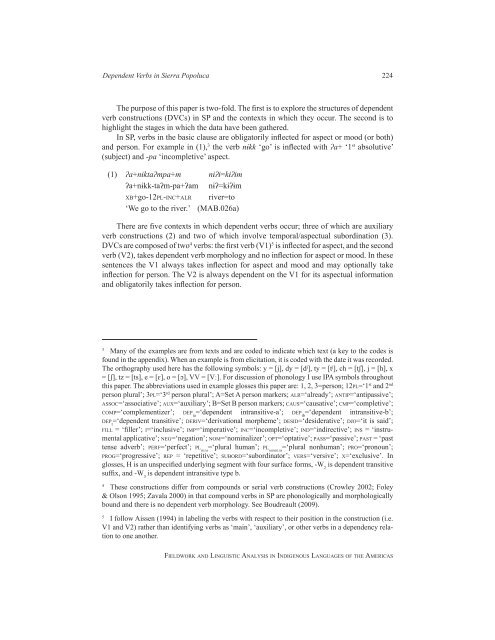Fieldwork and Linguistic Analysis in Indigenous ... - ScholarSpace
Fieldwork and Linguistic Analysis in Indigenous ... - ScholarSpace
Fieldwork and Linguistic Analysis in Indigenous ... - ScholarSpace
You also want an ePaper? Increase the reach of your titles
YUMPU automatically turns print PDFs into web optimized ePapers that Google loves.
Dependent Verbs <strong>in</strong> Sierra Popoluca 224<br />
The purpose of this paper is two-fold. The first is to explore the structures of dependent<br />
verb constructions (DVCs) <strong>in</strong> SP <strong>and</strong> the contexts <strong>in</strong> which they occur. The second is to<br />
highlight the stages <strong>in</strong> which the data have been gathered.<br />
In SP, verbs <strong>in</strong> the basic clause are obligatorily <strong>in</strong>flected for aspect or mood (or both)<br />
<strong>and</strong> person. For example <strong>in</strong> (1), 3 the verb nɨkk ‘go’ is <strong>in</strong>flected with ʔa+ ‘1 st absolutive’<br />
(subject) <strong>and</strong> -pa ‘<strong>in</strong>completive’ aspect.<br />
(1) ʔa+nɨktaʔmpa+m nɨʔɨ=kɨʔɨm<br />
ʔa+nɨkk-taʔm-pa+ʔam nɨʔ=kɨʔɨm<br />
xb+go-12Pl-<strong>in</strong>c+alr river=to<br />
‘We go to the river.’ (MAB.026a)<br />
There are five contexts <strong>in</strong> which dependent verbs occur; three of which are auxiliary<br />
verb constructions (2) <strong>and</strong> two of which <strong>in</strong>volve temporal/aspectual subord<strong>in</strong>ation (3).<br />
DVCs are composed of two 4 verbs: the first verb (V1) 5 is <strong>in</strong>flected for aspect, <strong>and</strong> the second<br />
verb (V2), takes dependent verb morphology <strong>and</strong> no <strong>in</strong>flection for aspect or mood. In these<br />
sentences the V1 always takes <strong>in</strong>flection for aspect <strong>and</strong> mood <strong>and</strong> may optionally take<br />
<strong>in</strong>flection for person. The V2 is always dependent on the V1 for its aspectual <strong>in</strong>formation<br />
<strong>and</strong> obligatorily takes <strong>in</strong>flection for person.<br />
3 Many of the examples are from texts <strong>and</strong> are coded to <strong>in</strong>dicate which text (a key to the codes is<br />
found <strong>in</strong> the appendix). When an example is from elicitation, it is coded with the date it was recorded.<br />
The orthography used here has the follow<strong>in</strong>g symbols: y = [j], dy = [d j ], ty = [t j ], ch = [tʃ], j = [h], x<br />
= [ʃ], tz = [ts], e = [ɛ], o = [ɔ], VV = [Vː]. For discussion of phonology I use IPA symbols throughout<br />
this paper. The abbreviations used <strong>in</strong> example glosses this paper are: 1, 2, 3=person; 12Pl=‘1 st <strong>and</strong> 2 nd<br />
person plural’; 3Pl=‘3 rd person plural’; A=Set A person markers; alr=‘already’; antiP=‘antipassive’;<br />
assoc=‘associative’; aux=‘auxiliary’; b=Set B person markers; caus=‘causative’; cmP=‘completive’;<br />
comP=‘complementizer’; deP ia =‘dependent <strong>in</strong>transitive-a’; deP ib =‘dependent <strong>in</strong>transitive-b’;<br />
deP t =‘dependent transitive’; deriv=‘derivational morpheme’; desid=‘desiderative’; dJo=‘it is said’;<br />
fill = ‘filler’; i=‘<strong>in</strong>clusive’; imP=‘imperative’; <strong>in</strong>c=‘<strong>in</strong>completive’; <strong>in</strong>d=‘<strong>in</strong>directive’; <strong>in</strong>s = ‘<strong>in</strong>strumental<br />
applicative’; neg=‘negation’; nom=‘nom<strong>in</strong>alizer’; oPt=‘optative’; Pass=‘passive’; Past = ‘past<br />
tense adverb’; Perf=‘perfect’; Pl hum =‘plural human’; Pl nonhum =‘plural nonhuman’; Pro=‘pronoun’;<br />
Prog=‘progressive’; reP = ‘repetitive’; subord=‘subord<strong>in</strong>ator’; vers=‘versive’; x=‘exclusive’. In<br />
glosses, H is an unspecified underly<strong>in</strong>g segment with four surface forms, -W 2 is dependent transitive<br />
suffix, <strong>and</strong> -W 3 is dependent <strong>in</strong>transitive type b.<br />
4 These constructions differ from compounds or serial verb constructions (Crowley 2002; Foley<br />
& Olson 1995; Zavala 2000) <strong>in</strong> that compound verbs <strong>in</strong> SP are phonologically <strong>and</strong> morphologically<br />
bound <strong>and</strong> there is no dependent verb morphology. See Boudreault (2009).<br />
5 I follow Aissen (1994) <strong>in</strong> label<strong>in</strong>g the verbs with respect to their position <strong>in</strong> the construction (i.e.<br />
V1 <strong>and</strong> V2) rather than identify<strong>in</strong>g verbs as ‘ma<strong>in</strong>’, ‘auxiliary’, or other verbs <strong>in</strong> a dependency relation<br />
to one another.<br />
fieldwork <strong>and</strong> l<strong>in</strong>guistic analysis <strong>in</strong> <strong>in</strong>digenous languages of the americas

















